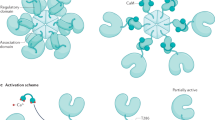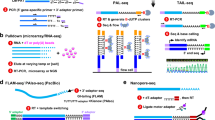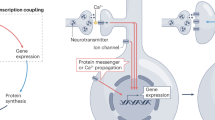Abstract
Ca2+-regulated gene transcription is essential to diverse physiological processes, including the adaptive plasticity associated with learning. We found that basal synaptic input activates the NF-κB transcription factor by a pathway requiring the Ca2+/calmodulin-dependent kinase CaMKII and local submembranous Ca2+ elevation. The p65:p50 NF-κB form is selectively localized at synapses; p65-deficient mice have no detectable synaptic NF-κB. Activated NF-κB moves to the nucleus and could directly transmute synaptic signals into altered gene expression. Mice lacking p65 show a selective learning deficit in the spatial version of the radial arm maze. These observations suggest that long-term changes to adult neuronal function caused by synaptic stimulation can be regulated by NF-κB nuclear translocation and gene activation.
This is a preview of subscription content, access via your institution
Access options
Subscribe to this journal
Receive 12 print issues and online access
$209.00 per year
only $17.42 per issue
Buy this article
- Purchase on Springer Link
- Instant access to full article PDF
Prices may be subject to local taxes which are calculated during checkout




Similar content being viewed by others
References
Graef, I.A. et al. L-type calcium channels and GSK-3 regulate the activity of NF-ATc4 in hippocampal neurons. Nature 401, 703–708 (1999).
Wellmann, H., Kaltschmidt, B. & Kaltschmidt, C. Retrograde transport of transcription factor NF-kappa B in living neurons. J. Biol. Chem. 276, 11821–11829 (2001).
Lu, D., Yang, H. & Raizada, M.K. Involvement of p62 nucleoporin in angiotensin II-induced nuclear translocation of STAT3 in brain neurons. J. Neurosci. 18, 1329–1336 (1998).
Lerant, A., Kanyicska, B. & Freeman, M.E. Nuclear translocation of STAT5 and increased expression of Fos related antigens (FRAs) in hypothalamic dopaminergic neurons after prolactin administration. Brain Res. 904, 259–269 (2001).
O'Neill, L.A. & Kaltschmidt, C. NF-kappa B: a crucial transcription factor for glial and neuronal cell function. Trends Neurosci. 20, 252–258 (1997).
West, A.E., Griffith, E.C. & Greenberg, M.E. Regulation of transcription factors by neuronal activity. Nat. Rev. Neurosci. 3, 921–931 (2002).
Kaltschmidt, C., Kaltschmidt, B., Neumann, H., Wekerle, H. & Baeuerle, P.A. Constitutive NF-kappa B activity in neurons. Mol. Cell. Biol. 14, 3981–3992 (1994).
Baeuerle, P.A. & Baltimore, D. I kappa B: a specific inhibitor of the NF-kappaB transcription factor. Science 242, 540–546 (1988).
Baeuerle, P.A. & Baltimore, D. Activation of DNA-binding activity in an apparently cytoplasmic precursor of the NF-kappa B transcription factor. Cell 53, 211–217 (1988).
Kaltschmidt, C., Kaltschmidt, B. & Baeuerle, P.A. Brain synapses contain inducible forms of the transcription factor NF- kappaB. Mech. Dev. 43, 135–147 (1993).
Meberg, P.J., Kinney, W.R., Valcourt, E.G. & Routtenberg, A. Gene expression of the transcription factor NF-kappa B in hippocampus: regulation by synaptic activity. Brain Res. Mol. Brain Res. 38, 179–190 (1996).
Beg, A.A., Sha, W.C., Bronson, R.T., Ghosh, S. & Baltimore, D. Embryonic lethality and liver degeneration in mice lacking the RelA component of NF-kappa B. Nature 376, 167–170 (1995).
Alcamo, E. et al. Targeted mutation of TNF receptor I rescues the RelA-deficient mouse and reveals a critical role for NF-kappaB in leukocyte recruitment. J. Immunol. 167, 1592–1600 (2001).
Giese, K.P., Fedorov, N.B., Filipkowski, R.K. & Silva, A.J. Autophosphorylation at Thr286 of the alpha calcium-calmodulin kinase II in LTP and learning. Science 279, 870–873 (1998).
Teruel, M.N. & Meyer, T. Translocation and reversible localization of signaling proteins: a dynamic future for signal transduction. Cell 103, 181–184 (2000).
Kohrmann, M. et al. Microtubule-dependent recruitment of Staufen-green fluorescent protein into large RNA-containing granules and subsequent dendritic transport in living hippocampal neurons. Mol. Biol. Cell 10, 2945–2953 (1999).
Nelson, G. et al. Multi-parameter analysis of the kinetics of NF-kappaB signalling and transcription in single living cells. J. Cell Sci. 115, 1137–1148 (2002).
Chang, B.H., Mukherji, S. & Soderling, T.R. Characterization of a calmodulin kinase II inhibitor protein in brain. Proc. Natl. Acad. Sci. USA 95, 10890–10895 (1998).
Fink, C.C. et al. Selective regulation of neurite extension and synapse formation by the β but not the α isoform of CaMKII. Neuron (in press).
Waldmann, R., Hanson, P.I. & Schulman, H. Multifunctional Ca2+/calmodulin-dependent protein kinase made Ca2+ independent for functional studies. Biochemistry 29, 1679–1684 (1990).
Hardingham, G.E., Arnold, F.J. & Bading, H. Nuclear calcium signaling controls CREB-mediated gene expression triggered by synaptic activity. Nat. Neurosci. 4, 261–267 (2001).
Deisseroth, K., Bito, H. & Tsien, R.W. Signaling from synapse to nucleus: postsynaptic CREB phosphorylation during multiple forms of hippocampal synaptic plasticity. Neuron 16, 89–101 (1996).
Hardingham, G.E., Arnold, F.J. & Bading, H. A calcium microdomain near NMDA receptors: on switch for ERK-dependent synapse-to-nucleus communication. Nat. Neurosci. 4, 565–566 (2001).
Schmidt-Ullrich, R. et al. NF-kappaB activity in transgenic mice: developmental regulation and tissue specificity. Development 122, 2117–2128 (1996).
Guerrini, L., Molteni, A., Wirth, T., Kistler, B. & Blasi, F. Glutamate-dependent activation of NF-kappaB during mouse cerebellum development. J. Neurosci. 17, 6057–6063 (1997).
Bhakar, A.L. et al. Constitutive nuclear factor-kappa B activity is required for central neuron survival. J. Neurosci. 22, 8466–8475 (2002).
McDonald, R.J. & White, N.M. A triple dissociation of memory systems: hippocampus, amygdala and dorsal striatum. Behav. Neurosci. 107, 3–22 (1993).
Hardingham, G.E., Chawla, S., Johnson, C.M. & Bading, H. Distinct functions of nuclear and cytoplasmic calcium in the control of gene expression. Nature 385, 260–265 (1997).
Deisseroth, K., Heist, E.K. & Tsien, R.W. Translocation of calmodulin to the nucleus supports CREB phosphorylation in hippocampal neurons. Nature 392, 198–202 (1998).
Dolmetsch, R.E., Pajvani, U., Fife, K., Spotts, J.M. & Greenberg, M.E. Signaling to the nucleus by an L-type calcium channel-calmodulin complex through the MAP kinase pathway. Science 294, 333–339 (2001).
Freudenthal, R. & Romano, A. Participation of Rel/NF-kappaB transcription factors in long-term memory in the crab Chasmagnathus. Brain Res. 855, 274–281 (2000).
Albensi, B.C. & Mattson, M.P. Evidence for the involvement of TNF and NF-kappaB in hippocampal synaptic plasticity. Synapse 35, 151–159 (2000).
Kandel, E.R. The molecular biology of memory storage: a dialogue between genes and synapses. Science 294, 1030–1038 (2001).
Jones, M.W. et al. A requirement for the immediate early gene Zif268 in the expression of late LTP and long-term memories. Nat. Neurosci. 4, 289–296 (2001).
Paylor, R., Johnson, R.S., Papaioannou, V., Spiegelman, B.M. & Wehner, J.M. Behavioral assessment of c-fos mutant mice. Brain Res. 651, 275–282 (1994).
Brown, J.R., Ye, H., Bronson, R.T., Dikkes, P. & Greenberg, M.E. A defect in nurturing in mice lacking the immediate early gene fosB. Cell 86, 297–309 (1996).
Maldonado, R., Smadja, C., Mazzucchelli, C., Sassone-Corsi, P. & Mazucchelli, C. Altered emotional and locomotor responses in mice deficient in the transcription factor CREM. Proc. Natl. Acad. Sci. USA 96, 14094–14099 (1999).
Cheng, H.Y. et al. DREAM is a critical transcriptional repressor for pain modulation. Cell 108, 31–43 (2002).
Banker, G. & Goslin, K. Culturing Nerve Cells (MIT Press, Cambridge, Massachusetts, 1990).
Basarsky, T.A., Parpura, V. & Haydon, P.G. Hippocampal synaptogenesis in cell culture: developmental time course of synapse formation, calcium influx, and synaptic protein distribution. J. Neurosci. 14, 6402–6411 (1994).
Meffert, M.K., Premack, B.A. & Schulman, H. Nitric oxide stimulates Ca2+-independent synaptic vesicle release. Neuron 12, 1235–1244 (1994).
Van Antwerp, D.J., Martin, S.J., Kafri, T., Green, D.R. & Verma, I.M. Suppression of TNF-alpha-induced apoptosis by NF-kappaB. Science 274, 787–789 (1996).
Chang, B.H., Mukherji, S. & Soderling, T.R. Calcium/calmodulin-dependent protein kinase II inhibitor protein: localization of isoforms in rat brain. Neuroscience 102, 767–777 (2001).
Axelrod, D. et al. Lateral motion of fluorescently labeled acetylcholine receptors in membranes of developing muscle fibers. Proc. Natl. Acad. Sci. USA 73, 4594–4598 (1976).
Lois, C., Hong, E.J., Pease, S., Brown, E.J. & Baltimore, D. Germline transmission and tissue-specific expression of transgenes delivered by lentiviral vectors. Science 295, 868–872 (2002).
Pomerantz, J.L., Denny, E.M. & Baltimore, D. CARD11 mediates factor-specific activation of NF-kappaB by the T cell receptor complex. Embo J. 21, 5184–5194 (2002).
Sage, J.R. & Knowlton, B.J. Effects of US devaluation on win-stay and win-shift radial maze performance in rats. Behav. Neurosci. 114, 295–306 (2000).
Acknowledgements
We thank E. Schuman and U. Bayer for support, discussion and critical reading of the manuscript, H. Schulman and his laboratory for the antCNt peptide, and E. Brown, A. Hoffman, J. Pomerantz and other members of the D. Baltimore laboratory for support and suggestions. We thank E. Alcamo for creating the double-knockout mouse line TNFR1/p65, which was critical to our experiments, and M. Sanders for training and assistance with behavioral assays. This work was supported by a National Institute of Neurological Disorders and Stroke (NINDS) KO8 grant to M.K.M. and a National Institutes of Health (NIH) grant to D.B.
Author information
Authors and Affiliations
Corresponding author
Ethics declarations
Competing interests
The authors declare no competing financial interests.
Supplementary information
Supplementary Fig. 1.
Glutamate induces GFPp65 translocation in neurons but not glia. (a) 3D reconstruction from Z-stacked confocal images of a mature hippocampal neuron in culture expressing GFPp65 after biolistic transfection. Bath stimulation with glutamate (250 μM) for 3 min results in a decrease of peripheral fluorescence and a gain in nuclear fluorescence 40 min later (lower panel). Scale bar represents 10 μm. (b) A glial cell in culture expressing GFPp65 after biolistic transfection is challenged with increasing concentrations of glutamate. An hour was allowed to elapse following each stimulation during which time nuclear fluorescence did not detectably increase. (c) The same glial cell depicted in a and b was washed and rested for 2 h prior to TNF-α (10 ng / ml) challenge. Nuclear fluorescence was visible at 20 min following stimulation with peak fluorescence occurring 60 min after the TNF-α addition. (JPG 52 kb)
Supplementary Fig. 2.
p65-dependent transcription of IκBα following stimulation. The time course of IkBa induction is examined by ribonuclease protection analysis of total RNA from basal and stimulated cultures of TNFR-/-,p65-/- and TNFR-/-,p65+/+ mice (indicated by yellow and blue, respectively). Neurons were pharmacologically silenced (see Methods) to obtain consistent basal conditions and stimulated by depolarization with 60 mM KCl. IκBα expression was significantly induced in p65-wildtype cultures at both 3 and 5 hours following stimulation, with expression declining between 3 - 5 hours (p = 0.5, n = 4). Induction of IkBa was significantly less in p65-deficient compared to p65-wildtype cultures at time points indicated by an * (p = 0.5, n = 4). Error bars represent one s.e.m.. (GIF 18 kb)
Supplementary Fig. 3.
Induction from κB-Luc reporter is NF-κB-dependent. Mature hippocampal neuronal cultures from wildtype or p65-deficient (TNFR-/-, p65-/-) mice were co-infected with lentivirus containing either an intact NF-κB-reporter gene (κB-luc) or an NF-κB reporter gene containing a mutated κB consensus site and, to permit normalization, a constitutively expressed β-galactosidase. Data shown are averaged replicates from 4 independent assays. All cultures were stimulated with bicuculline (50 mM, + 4-aminopyridine 5 μM). Error bars represent one s.e.m.. (GIF 20 kb)
Supplementary Fig. 4.
NF-κB activity is similarly reduced in both hippocampus and striatum. EMSA of extracts from striatum and hippocampus of p65-deficient (TNFR-/-,p65-/-) mature adult mice demonstrates that both tissues show a loss of κB-binding by p65-containing dimers without differential upregulation of other NF-κB activity (compare lanes 8,10). In p65-wildtype (TNFR-/-,p65+/+) but not in p65-deficient mice, DOC treatment reveals the presence of latent p50:p65 and p65:p65 (compare lanes 2,7 to lanes 9,11). SS denotes supershifted bands. The open arrowhead indicates a band which may correspond to the previously reported brain-specific transcription factor, BETA, which can bind κB sequencesS3 (see Supplementary Methods); both BETA and p65:p65 appeared more prominently in extracts from mature (>3 months) than young adult mice (data not shown). (JPG 59 kb)
Supplementary Fig. 5.
Quadrant crossings in p65-wildtype and deficient mice. Crossings between quadrants made by mice placed individually in a novel open-cage environment were measured for 3 min. Exploratory crossings made by p65-deficient mice (TNFR-/-,p65-/-) compared to p65-wildtype siblings (TNFR-/-,p65+/+) were not significantly different (17.1 ± 1.6, 18.2 ± 1.5, n = 10 for each genotype). Error bars represent one s.e.m.. (GIF 13 kb)
Rights and permissions
About this article
Cite this article
Meffert, M., Chang, J., Wiltgen, B. et al. NF-κB functions in synaptic signaling and behavior. Nat Neurosci 6, 1072–1078 (2003). https://doi.org/10.1038/nn1110
Received:
Accepted:
Published:
Issue Date:
DOI: https://doi.org/10.1038/nn1110
This article is cited by
-
Excitation–transcription coupling, neuronal gene expression and synaptic plasticity
Nature Reviews Neuroscience (2023)
-
Integration of nuclear Ca2+ transients and subnuclear protein shuttling provides a novel mechanism for the regulation of CREB-dependent gene expression
Cellular and Molecular Life Sciences (2023)
-
NEMO reshapes the α-Synuclein aggregate interface and acts as an autophagy adapter by co-condensation with p62
Nature Communications (2023)
-
DNA methylation landscapes from pig’s limbic structures underline regulatory mechanisms relevant for brain plasticity
Scientific Reports (2022)
-
Pinocembrin Relieves Mycoplasma pneumoniae Infection‑Induced Pneumonia in Mice Through the Inhibition of Oxidative Stress and Inflammatory Response
Applied Biochemistry and Biotechnology (2022)



